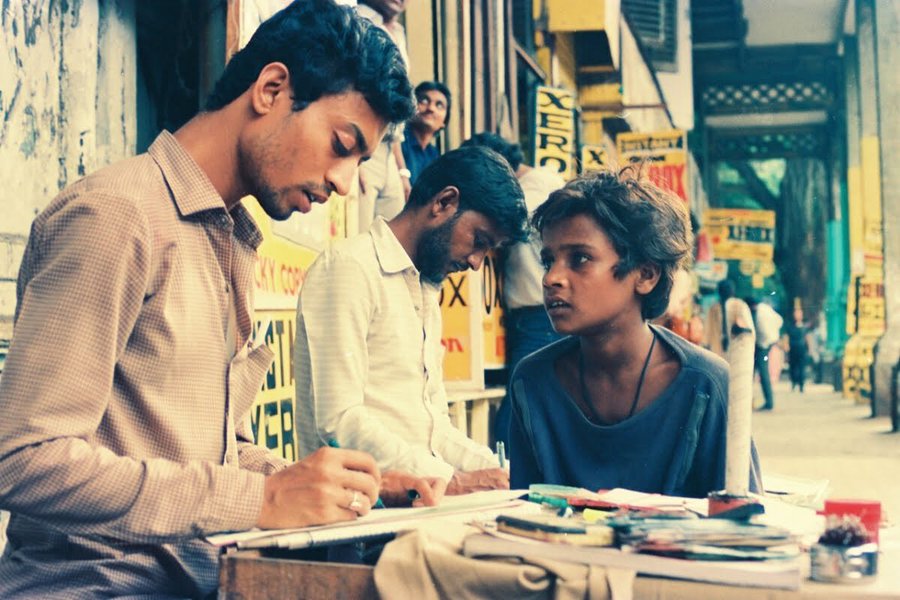There is no better film to illustrate the distinctive style of filmmaker Mira Nair than her debut feature film, Salaam Bombay!. Released in 1988, it showcases an approach to cinematic realism that stands poles apart from the broader trend in Bollywood/Indian cinema during that time period, even sitting at odds with Nair’s own upbringing in eastern India. While the filmmaker had shoulders of giants to stand on — the great naturalist, Satyajit Ray for one, alongside cinéma vérité masters like Jean Rouch — the movie was a dramatic departure from the standard Bollywood fare. Yet, it embodies a complete vision, appearing as the work of a thoroughly practiced hand.
In Salaam Bombay!, Nair approaches realism through reality itself. Instead of creating an isolated simulacrum of the reality it seeks to portray, the movie leans into its real-life settings, brimming with people living real lives, and narrates its story through non-actors — street children living that life themselves. In this manner, Nair utilises fiction to open a window into reality with all its authentic rhythms. Yet, in its unpretentious naturalism, the movie moves and draws you in, eventually giving rise to a third dimension on that threshold between reality and fiction: where thematic strokes and symbolic frameworks arise effortlessly, as it does in real life.
Nair’s filmography before this point was composed of a few documentaries, each brilliant in their own right, in which she explored completely new sides of the Indian experience. Her filmmaking journey started relatively late; she didn’t know she wanted to be a filmmaker until she went to America on a Harvard scholarship. There, she trained in the French cinéma vérité style, and discovered the wealth of India’s cinematic heritage, such as the Indian parallel cinema movement of the 1960s. She turned to documentary filmmaking as a natural extension of this experience, looking to her own history for stories worth telling.
It was during the filming of one of these documentaries (the 1984 television doc India Cabaret) that she happened upon the thread that would develop into Salaam Bombay!. Living for months with cabaret dancers of Bombay (now known as Mumbai), Nair saw how young street boys working in the local tea shops were essential characters woven into the fabric of the city — exploited and exposed to realities they were far too young to experience.
Her work with the cabaret dancers also opened her eyes towards the gleaming potential of approaching filmmaking from the ground level: During the filming of India Cabaret, and through the film’s reception, Nair discovered an unexpected pathos naturally embedded in real life, in the attitudes of the people living those grim realities, and in the colloquial language with which her subjects framed their thoughts and feelings. That pathos became the inception of Salaam Bombay!.
Nair wrote the script based on the experiences of the street kids she met, and went on to cast some of the same children in central roles. The result is a vivid portrait of Bombay’s dark underbelly, that has the peculiar naturalness of reality embedded into it — a window into its real-life rhythms, soaked in the colour of the drive and the aspirations of the multitudes, a colour today recognised as the spirit of Bombay itself, and pictured in so many cinematic love letters to the city that are now popular among Indian art film aficionados.

Couched in a certain romanticism, a certain rosiness, the film captures the contrasting dark side of the famous city without polishing off any of the grit. Within the obvious love for Bombay that the movie exhibits exists a unique cultural thread in Hindi cinema where the city often emerges as an entity all its own, a setting that is as alive as any character. It’s a cinematic touch that comes reflexively to every filmmaker and artist who once may have toiled those very streets — Bombay was and is often romanticized as India’s city of dreams, especially for those who dream of a career in Bollywood.
This particular connection to real world sensibilities, balanced delicately by the clear evocative power of a gentle, warm touch has proven to be a central element to all of Mira Nair’s films. The filmmaker, who has been quite generous with public discussions of her work over the years, has often reiterated these driving factors of her artistic pursuits, which seem to oppose each other at face value: the need to stay ruthlessly authentic to one’s own identity, and a desire to approach life’s harsh reprimands with a tender touch. Somewhere along these lines, Salaam Bombay! becomes enlivened with a soul that, in its natural motions, is thoroughly and quite visibly imbued with the deep sentiments that powers that naturalism.
The movie takes on the perspective of a newcomer to the streets of Bombay, a young boy named Krishna (Shafiq Syed) employed with a travelling circus. Sent to the nearby town on an errand, he returns to find the circus left without him. With no direction, he buys a train ticket to a “big city,” which just happens to be Bombay. There, he becomes one among the street boys, taking up a job at a tea shop and begrudgingly adopting the moniker Chaipaau (Hindi for tea and bread) given to him, hoping to earn enough money to go back home and take care of his mother.
During this time he meets myriad characters — a drug dealer named Chillum (Raghuvir Yadav) who becomes one of his closest friends, a former pimp named Baba (Nana Patekar) who runs the local drug trade, and even finding a maternal figure in Baba’s wife, Rekha (Anita Kanwar), a sex worker and mother to a young daughter. Befriending a group of street boys, Chaipaau also works a variety of odd jobs, hoping to save up for his eventual departure.
The movie, which runs for nearly two hours, feels evenly divided between plot developments and ruminations, moving seamlessly between each other with absolutely no differentiation. Each scene holds a thread that ties into the film’s conclusion, and amid these beats, idle moments arise that reflect the inner selves of many of these characters. A liberating rhythm sits outside the rigid cause-and-effect tensions of a typical commercial film. Events appear to take place without pretension, unburdened by the expectation to have a sense of active sense of moving to and from a place. The constant presence of diegetic sounds — very often the dull, ever-present blare of the surrounding traffic — continually emphasizes the tangible nature of the setting.
A similar approach is seen in the visual compositions. The movie’s interactions are never divorced from the settings where they take place — it can be one among the myriad of streets pictured in the film, or the crowded and very public hallways where Chaipaau goes to do his deliveries. Environment features prominently in how Nair frames her scenes. There are also many long-distance shots that essentially force the actors to play out the scene on their own accord, while the camera shoots from afar.
Strokes of brilliance in storycraft insert themselves surreptitiously amidst this form of realism. Chaipaau’s journey as the protagonist is a heartrending play of a determined character who eventually becomes a product of his environment. Minor and major characters seem to be drawn with an eerie real-life complexity upon the dotted lines of how they approach the hostility necessary to survive in their environment — some are amicable, others are protective, and still others seem to treat their dealings with the street boys with honesty despite a crude tongue. Meanwhile, the worst characters approach their cruel acts with a seeming sadistic pleasure mixed with self-righteousness.

Scenes of rumination include something as playful as Rekha and her daughter composing shadow animals on the wall; and can be as heartbreaking as the daughter playing alone while her mother services a client in the next room. Playing with the many display pieces in the client’s home, the scene reveals through symbols the broken psyche of a child filled with a desire for belonging, and damaged by her proximity to the sex trade.
As a personal preference, one of my favourite things a filmmaker can do is playing out story beats solely in the eyes of the actors. Salaam Bombay! ends with one such scene. The movie does a fantastic job of differentiating Chaipaau from his peers throughout its runtime, but by the end, he has experienced some significant setbacks that has finally brought reality crashing down around him. He makes a final play to escape his circumstance, murdering Baba during his argument with his wife, Rekha, who finally has decided to leave her life at the brothel. But once out on the street, they lose each other in the crowded procession of the Ganesh festival celebrations.
The final scene takes place in an abandoned alleyway where Chaipaau comes to rest after losing Rekha. He finally breaks down under the frustration of the months past, but his tiny wail stops suddenly, almost in a dark, sinister manner. The last frames of Salaam Bombay! capture a distinct change in Chaipaau’s eyes: a permanent darkness and rage that has finally settled into his soul, which had thus far been averted by his hopeful aspiration.
The opening and closing bookmarks set by a very local cultural symbol in the form of the Hindu deity Ganesh, the god of beginnings, is another overt fictional element that frames Chaipaau’s story as a single loop in an endlessly recurring cycle; this message is further emphasized by the appearance of another Chillum in the street boys’ community who, like Chaipaau’s late friend, is a drug addict who funds his habit by dealing.
Yet in the multitude of these storytelling elements, Salaam Bombay! never moves away from its carefully captured realism. One notes the distinct path it treads, away from the commercial cinema of its time, obviously, but perhaps also from the works of Indian art film pioneers. The former was characterized by a paint-by-numbers approach that appealed to viewers by hitting the mark with its stylized melodrama and a healthy mix of commercial genre elements. Meanwhile, the latter often held its awe-inspiring realism inside the stiff bounds of an elevated tone — effectively telling stories inside a buffer zone where the viewer has the privilege of emoting amid the isolation of a heightened fictional environment.
Salaam Bombay! banishes these differences, and the walls inside which a film makes its point. The movie pushes its story upon its real setting with a definitive motion. Behind the scenes, humorous anecdotes emerged of how its cast members had to contend with the locals, who were living their own real lives, while shooting certain scenes; other anecdotes describe how the older cast members had to manage the younger cast’s emotional vagaries. In that real-world setting a flower blooms, drawn from the real-life experiences of the street kids playing out their own shared stories, gently molded by the cinematic devices put forth by Nair.
This essay is part of our Director Retrospective series on Mira Nair. Check out our past series here, where we discuss the works of Wong Kar-wai, Hayao Miyazaki, and others!
















